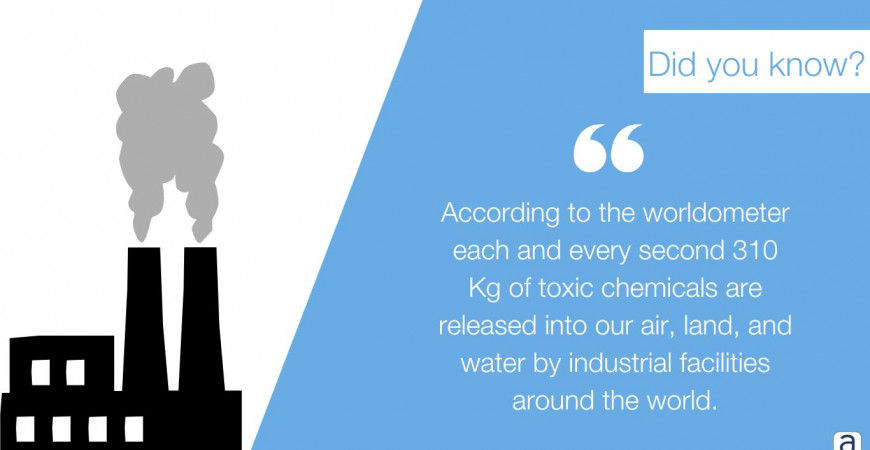Impacts of harsh chemicals on our environment and our lives.
Harsh Chemicals impact on our environment and our lives.
Have you ever thought about the impacts the harsh chemicals have on our environment and on us? All those warnings ⚠ on the labels of the products we are using everyday are so common to us that we do not even notice them anymore. Chemicals are everywhere!
And it is not going to change any sooner as the chemical industry is a growing market that is expected to grow even more in the years to come after a surge due to the pandemic. The dangers to the environment and to ourselves have never been so true and yet when it comes to sustainability, chemicals are rarely a topic we talk about...
The picture below shows the percentage increase year on year per region in the world of the production of chemicals:
_1.jpg)

As you can see on the graph above from EPA, the production of chemicals from 2011 to 2020 increased by 6.9 billion pounds (79%). The percent contribution of each of the top sectors to production-related waste management has remained relatively constant since 2011 with the exception of chemical manufacturing, which accounted for 39% of all production-related waste managed in 2011 and increased to 57% in 2020.
How we manage chemicals is then critical.
According to a research conducted by EWG'S Guide to Health Cleaning, over 2,000 common cleaning products from almost 200 brands and assessed the toxicity of more than 1,000 ingredients used. That is over 1000 ingredients in cleaning products with levels of toxicity!
Also according to the worldometer each and every second 310 Kg of toxic chemicals are released into our air, land, and water by industrial facilities around the world. That is around 10 million tons of chemicals into the environment and that is only for industrial uses! Now you can imagine if we were to include all the chemicals used by households…
A study conducted by the United States Geological Survey in 2002 found detergent traces in 69% of streams and 66% of streams containing disinfectants across the USA. and that was in 2002… Not only that, according to the Environmental Working Group's (EWG), there are more than 250 chemicals that are found in America’s drinking water.
And that was already 22 years ago...
In a research published in 2016, WHO has stated that around 1.6 million people have died and their death is directly and/or indirectly related to chemicals and there has been a rise in this trend since 2012.
Not only the cleaning solutions but the packaging of them have a huge impact on the environment. Most of the chemical productions nowadays are traditional and linear: the old fashioned Take - Make - Dispose model. This means the raw materials are extracted in one place, modified in another, shipped and then stored in another and shipped again then dispatched to shops where consumers can purchase them, use them and throw the contaminated plastic containers after use. That linear way of production creates loads of plastic waste and has a huge CO2 footprint.
According to the UN every minute one million plastic bottles are being purchased and around five trillion plastic bags every year are being used worldwide. Half of all plastic produced is designed for single-use purposes. This creates around 400 million tonnes of plastic waste every year.
While a vast majority of this million plastic bottles is for water consumption, plastic bottles and containers for chemicals are also a big part of it and the worst to recycle as they are polluted by the chemicals they contain.
And it is happening very close to our shores, like in Bali or Thailand for example, our lakes, rivers and oceans are filled with plastics. You can just follow Instagram’s accounts like sevencleanseas and garybencheghib to get an idea of the extent of the problem.
To tackle the plastic issues we usually look at downstream and upstream solutions: Downstream is linked to better waste management and recycling options but in SEA we do still have a lot of places with public or unofficial open air dumpsites with no waste treatment whatsoever. Upstream solutions are solutions to prevent single use plastic like reuse options. At this stage of the problem, we need both upstream and downstream solutions though upstream solutions are the most effective ones as you cut the problem at its roots.
Aquama is part of the upstream solutions as we promote the refill system which leads to no plastic wastes and no recycling needed. If we look at Singapore, there are 1.7 million households. With around 30 cleaning solution bottles used per year per household that is 51 million cleaning solution bottles per year for Singapore alone. With an average of 0.6 Kg per bottle that represents around 306K Tons of plastic waste. That is how much we could save with a refill system in place!
Unlike many other cleaning solutions, aquama® solution is only made from salt water and electricity. It is then eco-friendly and does not contain any hazardous chemicals. Based on an analysis conducted in January 2022 by Greenly, aquama®’s LCA (Life Cycle Assessment) shows that the carbon footprint of aquama® over a year of usage considering one spray per month is equivalent to 300 metres by a car and is 100 times less than many other chemicals.
2023, time for a change in your cleaning habits?


